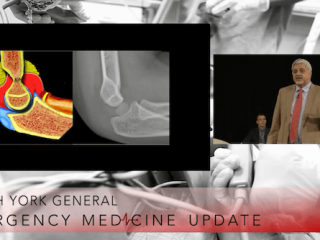Most Recent
EMU 365 Pediatric Elbow Nightmares with Arun Sayal
This is the 2nd instalment of The Emergency Medicine Update Conference's recently launched EMU 365 video series. In this EMU 65 video, Dr. Arun Sayal, an emergency physician who runs a weekly minor fracture clinic at NYGH discusses his approach to pediatric elbow injuries, the importance of good lateral images, common and uncommon missed elbow injuries and clinically important epicondylar fractures that can mimic normal ossification centers and more...
Ep 115 Emergency Management of the Agitated Patient
Managing acutely agitated patients can cause anxiety in even the most seasoned emergency doctor. These are high risk patients and they are high risk to you and your ED staff. It’s important to understand that agitation or agitated delirium is a cardinal presentation – not a diagnosis. There is pathology lurking beneath - psychiatric, medical, traumatic and toxicological diagnoses driving these patients and we just won’t know which until we can safely calm them down...
BCE 75 Reuben Strayer’s Agitated Patient
In anticipation of Episode 115 Management of the Agitated Patient, Dr. Reuben Strayer tells the story of the case that got him interested in developing an expertise around management of the agitated patient that includes an important simple pitfall and pearl about physical restraint. It that could prevent a death in your ED...
WTBS 16 Listening for the QI Signal in the Noise of ED Return Visits: Focus on Missed MI
Jesse McLaren outlines 10 Quality Improvement (QI) opportunities for reducing missed AMIs and the lessons learned from Ontario’s Emergency Department Return Visit Quality Program in this Waiting to Be Seen blog...
POCUS Cases 5 – Small Bowel Obstruction
In this POCUS Cases 5 - Small Bowel Obstruction, Dr. Simard explains the limitations of x-rays for small bowel obstruction, the three signs of small bowel obstruction on POCUS including the "keyboard sign", the most important literature on the topic and the limitations of using POCUS for the diagnosis of small bowel obstruction...
JJ 13 Regional Nerve Blocks for Hip Fractures
In this EM Cases Journal Jam podcast with Anton Helman, Justin Morgenstern, Rory Spiegel, and special guest Jacques Lee we explore the evidence for femoral nerve blocks and fascia iliaca blocks as well as discuss the practical implementation of them in your ED. We answer questions such as: Do regional nerve blocks for hip fractures effectively reduce pain? Do they decrease opioid use? Are they safe compared to standard pain management? Should the block be done prior to x-ray confirmation? and many more...







